Text
Are media representations of fans as ‘weird’ and ‘overly emotional’ fair?
In pop culture, fan communities are the lifeblood of artists, forming dedicated followings that transcend mere admiration. However, these fervent and passionate groups often fall victim to misrepresentation in media narratives, characterised as 'weird' and 'overly emotional' by various media outlets.
I believe these stereotypical characterisations of fans by the media and the general public are unjust and unfair. We will find out why in this blog by looking at fans of Taylor Swift, also known affectionately as 'Swifties', and my own experiences in fandom.

Swifties
Taylor Swift isn't just a global music icon; she's also got a colossal fanbase that spans the planet. But let's talk about a not-so-fun part of being a fan: the stereotypes.
You might have heard that Swifties are 'obsessive' or 'weird' because they'll tattoo her lyrics on their bodies, analyse her every move, or get super invested in her love life (karma is the guy on the Chiefs!).
Sure, there have been some not-so-great moments, like stalking and breaking in (which is entirely not okay, by the way) or crowding at places just to get a glimpse of her. For example, hundreds of fans crowded outside Jack Antonoff's private wedding event to see Taylor Swift walk out the door and enter her car within 5 seconds, and it was NOT cool for so many reasons!
However, those actions don't define the millions of fans out there. These stereotypes overshadow fans' genuine love and support for Taylor and her music. And you know what? Taylor herself encourages this enthusiasm!
For example, she loves dropping hints for fans to pick up. Be it interviews, talk shows, award ceremony speeches or even her own music videos and live concert performances, Taylor almost always leaves clues about her next move, especially regarding her future works. A great example of Taylor being an absolute mastermind (pun intended!) when it comes to Easter eggs is her Bejeweled music video, where she gave many indications that she will be dropping the rerecording of Speak Now (Taylor's Version) next while paying tribute to her other "eras" as well. Taylor herself even admitted that her team kept a PDF for all the Easter eggs they dropped in the Bejeweled music video, and we don't blame her!
youtube
The bond between Taylor and her fans isn't the only enchanted thing in this fandom: Swifties have successfully fostered a community of support, empathy and solidarity among the members. An example that showcased the love and care of the fanbase was when a fan tragically passed away due to heat before one of Taylor Swift's concerts in Rio de Janeiro recently.
Rather than just mourning the loss, Swifties rallied together and raised funds to ensure that the fan's body could be transported back to her family, displaying an incredible level of compassion and unity.
But that's not the only instance where the fans showcased solidarity beyond their shared admiration for Taylor Swift. When unfortunate accidents occurred involving fellow fans — like the fan who got into a car accident returning from a concert or the one who was mugged and killed on the way to a show — the community stood together in support. They paid tribute, remembered, and honoured these individuals on social media, showcasing a deep sense of humanity and compassion that transcends the bounds of fandom stereotypes.
These incidents paint a different picture of Taylor Swift's fanbase — one that's deeply connected, empathetic, and caring. They're not just fans; they're humans with genuine feelings and hearts, demonstrating that the bonds within this community extend far beyond their shared love for an artist.
These stories are a testament to the power of human connection within the Swiftie community, showcasing that they're much more than the unfair and lousy stereotypes suggested.
My own experiences in fandom
Now, the topic of discussion will have to take a significant leap into the world of anime.

While I am a massive fan of Taylor Swift, I don't have a fan account for her, nor do I engage much with other Swifties online. However, I am guilty of being on anitwt (fandom slang; the community of anime fans and anime-focused accounts on Twitter/X) for a few years already, and the very fandom that I indulge in is mainly Haikyuu!!, a manga-turned-anime that follows the main character, Hinata, throughout high school as he chases his passion for volleyball, ultimately making his mark in the professional circuit.
Interacting with fellow fans within this community has been an eye-opening and heartwarming experience. Beyond their shared passion for our common interest, I've realised that these fans possess incredible qualities that have shaped my perception of them in the most positive ways.
Firstly, their kindness knows no bounds. It's not just about praising the content; it's about uplifting each other. Whether someone shares a drawing, a captivating 'threadfic,' or expresses a challenging moment, the response is a flood of unwavering love and support. The comment sections resonate with encouragement, and there's always this beautiful energy of cheering each other on.
Moreover, their willingness to extend a helping hand is truly remarkable. I've witnessed instances where a fellow fan faced financial struggles — unable to cover rent or facing hefty hospital bills — and the community rallied, generously donating to ease their burden. It's not just about admiration for our shared interests; it's about being there for one another in times of need.
But what indeed resonates with me is their genuine heart for making a positive impact. Many fans, especially those with large followings, use their platforms beyond fan-related content. They fearlessly call out toxic behaviours within the community or passionately advocate for crucial social issues. It's a courageous act, utilising their influence for the greater good, amplifying awareness beyond the realms of our shared interest.
Most incredibly, the friendships formed here aren't just digital connections; they transcend borders. Fans from all corners of the globe become real friends, meeting up whenever they travel to each other's countries. I've been fortunate to receive several invitations to meet, reinforcing my belief in this community's tightly-knit and inclusive nature.
Conclusion
From observing the Swifties communities to analysing my own experience in fandom, I believe that the media representations of fans as 'weird' and 'overly emotional' are unfair.
Fans are not just admirers of a common interest; they are compassionate, generous, and fearless individuals who use their connections to foster a community of support, advocacy, and genuine friendship. It's a reminder that amidst shared enthusiasm, the human connection is what truly defines a community.

---
References
Bailey, A 2022, Every Easter egg in Taylor Swift's ‘Bejeweled’ music video, Elle, viewed 27 November 2023, <https://www.elle.com/culture/music/a41760214/taylor-swift-bejeweled-music-video-easter-eggs/>.
Lakritz, T 2023, Taylor Swift's Eras Tour is about to go international. Here's a guide to every era of her groundbreaking career., Business Insider, viewed 27 November 2023, <https://www.insider.com/taylor-swift-eras-tour-guide-to-every-album-era-2022-12>.
Noyen, M 2023, Swifties labeled 'disrespectful' for swarming Jack Antonoff and Margaret Qualley's wedding rehearsal to catch a glimpse of Taylor Swift, Business Insider, viewed 27 November 2023, <https://www.insider.com/taylor-swift-fans-slammed-for-swarming-jack-antonoff-wedding-rehearsal-2023-8>.
Swift, T 2022, Bejeweled, 25 October, viewed 25 October 2023, <https://www.youtube.com/watch?v=b7QlX3yR2xs&pp=ygUWYmVqZXdlbGVkIHRheWxvciBzd2lmdA%3D%3D>.
Taylor Swift: 1989 (Taylor’s Version); Why is Taylor Swift re-recording old albums? 2023, Taylor Swift: 1989 (Taylor’s Version); Why is Taylor Swift re-recording old albums?, The Economic Times, viewed 27 October 2023, <https://economictimes.indiatimes.com/news/international/us/taylor-swift-1989-taylors-version-why-is-taylor-swift-re-recording-old-albums/articleshow/104761223.cms>.
2 notes
·
View notes
Text
Do the benefits of online gaming outweigh the pitfalls?

Online gaming has evolved into a global phenomenon, captivating millions with its immersive experiences and social connectivity. Yet, amidst its allure, a debate persists: do the benefits of online gaming outweigh the potential pitfalls?
In this blog post, I will explore the advantages and disadvantages of social gaming.
The COVID-19 Situation

In the midst of the COVID-19 pandemic, the world witnessed a surge in online gaming (Teng et al. 2021).
Surprisingly, gaming was not considered an activity carried out to pass the time; it became a coping mechanism for many. As the pandemic gripped our lives, adults grappling with increased anxiety turned to video games, seeking solace in the virtual realms to counter the pervasive stress caused by the outbreak (Teng et al. 2021).
Similarly, children and teens who faced the strains of a disrupted routine found relief in gaming, using it as a tool to alleviate the pressures induced by this unprecedented global stressor (Teng et al. 2021).
Therefore, it can be observed that individuals who spend more time gaming feel less stressed and anxious as gaming provides an outlet to release tension (Wu et al. 2022).
Safe Haven, Safe Space

But, gaming can also be more than just stress relief.
Gaming became a haven for various groups who struggle with social interactions or mental health challenges. For those with autism spectrum disorders, insecure attachment styles, or experiencing depression or social anxiety, online gaming offers a safe space (Fishman 2023).
When playing games online, socializing doesn't demand the conventional skill sets of face-to-face interactions (Fishman 2023). Instead, it provides a platform where individuals can communicate at their own pace, devoid of immediate pressures or the need for physical presence (Fishman 2023).
This environment nurtures connections and friendships, fostering confidence and skills that might translate into real-world interactions, eventually bridging the gap between virtual and physical social spheres.
...And the Power of Friendship!

Research even highlights the success stories where virtual friendships formed through gaming transitioned into real-life connections (Fishman 2023). This unique ability of video games to act as a training ground for social skills, building the confidence needed to step into real-world interactions, stands out as a hidden gem amidst the pixels and quests.
While gaming has often been criticized for its potential negative impacts, the pandemic revealed its underrated role as a coping mechanism, a safe space for social experimentation, and a pathway to develop crucial interpersonal skills for those who find traditional social scenarios challenging.
Pitfalls
However, we must also discuss the negative impacts of online gaming, no matter how tired we are of hearing them.

1. Addiction (Advantages and Disadvantages of Online Games 2023). These games, with their immersive experiences, have a sneaky way of pulling people in, sometimes to the point where it becomes challenging to hit pause. Falling into this digital rabbit hole can mean hours slipping away, affecting productivity and even sparking feelings of depression (Advantages and Disadvantages of Online Games 2023). It's a fine line between enjoyment and dependency, one that many gamers might find themselves tiptoeing.
2. Then there's the toll on health, both physical and mental (Advantages and Disadvantages of Online Games 2023). Think about it: hours hunched over a screen can wreak havoc on your body — posture problems, wrist issues like carpal tunnel syndrome, headaches, and eye strain (Advantages and Disadvantages of Online Games 2023).
3. Potential danger lurking in the virtual shadows (Advantages and Disadvantages of Online Games 2023). While online spaces have become safer thanks to reporting features and chat filters, there's still a risk, especially for kids who might unknowingly interact with strangers. There've been cases of adults with malicious intent using gaming platforms to connect with children and teens (Advantages and Disadvantages of Online Games 2023). It's become rare, but the risk remains, highlighting the importance of vigilant parenting and open conversations about online safety (Advantages and Disadvantages of Online Games 2023).

Conclusion
In weighing the scales of online gaming, it's undeniable that the benefits are impactful. From being a sanctuary during times of stress to fostering friendships that transcend the virtual realm, its positive influence is tangible.
However, the pitfalls loom with substantial weight. Addiction, both psychologically and physically detrimental, casts a shadow over the immersive experiences. Health concerns, from posture problems to mental health issues, serve as red flags as our health cannot be traded back so easily. Most significantly, the lurking dangers in the form of potential risks to younger gamers underscore the necessity for vigilant supervision and conversations around online safety.
Despite the undeniable allure and the many positives, the pitfalls surrounding online gaming paint a stark picture. While it offers solace, friendships, and skill-building opportunities, the risks to mental and physical health and potential dangers tilt the balance unfavourably. As such, the benefits, however significant, seem overshadowed by the substantial pitfalls, making it challenging to assert that the benefits of online gaming outweigh the potential risks.
---
References
Advantages and Disadvantages of Online Games 2023, Advantages and disadvantages of online games, EDUCBA, viewed 26 November 2023, <https://www.educba.com/advantages-and-disadvantages-of-online-games/>.
Fishman, A 2023, Video games are social spaces: how video games help people connect, Response for Teens, viewed 26 November 2023, <https://www.jcfs.org/response/blog/video-games-are-social-spaces-how-video-games-help-people-connect#:~:text=Online%20video%20games%20can%20allow,to%20try%20it%20in%2Dperson.>.
Teng, Z, Pontes, HM, Qian Nie, Griffiths, MD & Cheng Guo 2021, ‘Depression and anxiety symptoms associated with internet gaming disorder before and during the COVID-19 pandemic: A longitudinal study’, Journal of Behavioral Addictions, vol. 10, no. 1, pp. 169-180.
Wu, Q, Luo, T, Tang, J, Wang, Y, Wu, Z, Liu, Y, Chen, W, Deng, Q & Liao, Y 2022, ‘Gaming in China before the COVID-19 pandemic and after the lifting of lockdowns: a nationwide online retrospective survey’, International Journal of Mental Health and Addiction, vol. 21, pp. 3293-3305.
Yang, Y 2023, Games of death: online anger as family of China student who died after marathon livestream gaming sessions offered RM3,200 ‘humanitarian’ payout, The Star, viewed 26 November 2023, <https://www.thestar.com.my/tech/tech-news/2023/11/27/games-of-death-online-anger-as-family-of-china-student-who-died-after-marathon-livestream-gaming-sessions-offered-rm3200-humanitarian-payout>.
1 note
·
View note
Text
Is Social Media Visibility a Double-Edged Sword for Activists?

Social media can amplify voices and galvanize movements across the globe. Yet, this powerful tool has its complexities. While it provides a platform for widespread dissemination of ideas and mobilization, it also brings forth challenges of misinformation and surveillance.
In this blog, I will explore the advantages and pitfalls that come hand in hand with the digital spotlight to answer the question: is social media visibility a double-edged sword for activists?
Advantages of Online Visibility for Activists
Picture this: a world where activists can reach their immediate community and the entire globe.

That's the power of social media.
These platforms have become the superheroes of activism, allowing voices to echo far beyond local streets. They're the megaphones for movements, helping messages resonate across diverse populations worldwide.
What's fascinating is their ability to turn moments into movements. Think of the striking images and videos capturing the essence of protests. These aren't just snapshots; they're catalysts. Social media isn't just a meeting ground for like-minded souls; it's a gateway to traditional media (Uldam 2018, p. 49). When powerful visuals hit the screens, they're not just viral online but making headlines. That ripple effect takes what started digitally into the mainstream, shaping public discourse.

But it's not just about speaking to the converted. The online bridge to traditional media ensures that these actions don't stay within activist circles. They break through, reaching beyond, grabbing the attention of people who might not have been listening before. Social media's role in connecting offline actions to a broader audience is crucial. It's the fuel that powers visibility, pushing boundaries and influencing opinions on a larger scale.
The Pitfalls of Online Visibility for Activists
Yet, every coin has two sides.
The spotlight that social media shines on activists casts shadows, too. While it's a megaphone, it's also a magnifying glass. Activists find themselves not just reaching out but being watched closely — often by entities with vested interests.
This visibility isn't a two-way street. It's more like a peephole — activists are exposed while corporations and governments stay hidden. Social media becomes a tool for surveillance, giving these entities the upper hand in monitoring activities without being held to the same standards of transparency (Uldam 2018, p. 45).

The power dynamics play out starkly here. As activists strive to be seen, they unwittingly open themselves to surveillance. Governments and companies use this transparency to their advantage, keeping tabs on specific groups or movements. It's a selective lens, focusing attention on activists while evading scrutiny themselves.
It's a paradox: the activists' very tool used to amplify their voices becomes a means of control and surveillance. As visibility grows, so does the risk of scrutiny. This imbalance in transparency between activists and the watchers through social media creates a challenging landscape—one where visibility, intended to empower, ends up being a tool for control and surveillance.
Balancing Visibility and Impact
So, how can activists navigate this digital landscape while harnessing the benefits of social media visibility and mitigating its pitfalls?
1. Authenticity over virality (Newberry & Reid 2022)
Activists should prioritize authenticity in messaging rather than aiming solely for virality. Authentic content resonates deeply and fosters genuine connections, which can lead to sustained support and meaningful impact.
2. Community Building (Newberry & Reid 2022)
Focusing on building engaged communities rather than just amassing followers can build strong, supportive communities, provide a resilient foundation for activism and offer protection against online harassment.
3. Mindful Engagement (Newberry & Reid 2022)
By providing context to complex issues and sharing their stances, activists can encourage online conversations that promote understanding and empathy.

Conclusion
In conclusion, social media visibility is both a boon and a bane for activists. It's an unparalleled tool that amplifies voices, connects diverse communities, and catapults movements onto the global stage. Yet, this digital spotlight brings challenges — misinformation, surveillance, and the risk of commodifying causes.
Navigating this complex landscape demands a delicate balance. Activists must harness the power of social media while being mindful of its pitfalls. Prioritizing authenticity in messaging, fostering engaged communities, and promoting mindful engagement can be crucial steps toward leveraging online visibility effectively.
Ultimately, the digital realm offers immense potential for activists to drive change and ignite conversations. Embracing its strengths while safeguarding against its pitfalls allows activists to wield the digital double-edged sword more effectively in pursuing meaningful impact and social transformation.
---
References
Ambrose, J 2023, 'Shell sues Greenpeace for $2.1m in damages over fossil fuel protest in North Sea', The Guardian, 9 November, <https://www.theguardian.com/business/2023/nov/09/shell-sues-greenpeace-over-fossil-fuel-protest-in-north-sea>.
Newberry, C & Reid, A 2022, ‘Social media activism in 2023: how to go beyond the hashtag’, Hootsuite, 26 September, viewed 24 November 2023, <https://blog.hootsuite.com/social-media-activism/>.
Uldam, J 2018, ‘Social media visibility: challenges to activism’, Media, Culture & Society, vol. 40, no. 1, pp. 41-58.
3 notes
·
View notes
Text
Can Social Media Shape the Outcome of Elections?
Politicians have a long history of seizing every opportunity to gain more supporters, boost their reputation and communicate their stances on various issues.

After all, the essence of electioneering lies in engaging with voters to sway their voting choices. Politicians have begun leveraging these tools for message dissemination and cultivating personal relationships in an increasingly interconnected world where social networking platforms form, facilitate, and catalyse connections.
Social media equipment in today's political landscape has impacted how political messages are spread, how candidates and parties are promoted, and how politicians engage with the voters and the general public. Understandably, politicians utilise social media in favour of the image and parties they promote, but can the influence of social media ultimately shape the outcome of elections?

In this blog, I will explore how social media has changed and impacted the outcome of modern politics and elections.
Why do politicians use social media in the first place?
We all have social media (or, at least, most of us do). Even right now, you are using social media to view this blog.

Ordinary people like you and I use social media for significantly different purposes from politicians. Here are a few reasons why politicians use social media:
1. Direct connection with constituents (Beveridge & Tran 2023). For example, platforms like Twitter (now known as X), Facebook, and Instagram offer a vast audience reach, enabling politicians to disseminate their messages, policies, and ideologies swiftly and widely. These platforms act as a direct channel for communication, allowing politicians to engage with voters in real time, respond to queries, and address concerns promptly.
2. Cost-effectiveness (Beveridge & Tran 2023). Unlike traditional forms of campaigning, which often require substantial financial resources for advertising, social media platforms offer an essentially free or low-cost means of reaching a vast audience. With minimal financial investment, politicians can disseminate their messages, engage directly with constituents, and cultivate a strong online presence. This cost-effective nature democratises access to a broad audience, levelling the playing field for candidates with limited campaign budgets, and allows for agile and targeted outreach strategies without the constraints of hefty advertising expenses.
3. Authenticity (Beveridge & Tran 2023). Social media offers politicians a unique platform to redefine perceptions. It's an opportunity to break stereotypes by showcasing authenticity, transparency, and accessibility. Politicians can humanise their image by engaging directly with the public, fostering accountability and trust while creating a more relatable and open dialogue between leaders and the people they serve.
How do politicians utilise social media to their benefit?
Like every other user, politicians utilise social media platforms by establishing profiles or accounts. This allows users to 'friend,' 'like,' or 'follow' them, enabling interaction through posts or tweets (Cameron, Barrett & Stewardson 2016).
Younger politicians tend to have a more substantial online presence across social media platforms, especially on Instagram and TikTok, where younger demographics are targeted. For example, Syed Saddiq, the 30-year-old Member of Parliament for Muar in Malaysia, is an active user of Instagram and TikTok, where he shares a variety of content from snippets of political debates in the parliament to videos of his family and his late pet cat, Toby (fly high, Toby).

This way, Syed Saddiq adeptly connects with supporters and potential voters through his social media presence by intertwining authenticity, relatability, and engagement. He can foster a genuine connection with his audience as he shares not only political stances and beliefs but also personal moments online. Not only that, Syed Saddiq also successfully garners the attention of the younger generation due to his relatable and trendy posts, enticing more people to pay attention to the things that he shares online.
So, can social media really shape the outcome of an election?
Absolutely!

While traditional media and campaign strategies remain significant, they are now integrated with social media.
As politicians shift towards utilising social media, they are presented with unprecedented control over information flow, enabling direct, unfiltered communication with supporters and potential voters, which could significantly sway the election to a candidate or party's favour (Cameron, Barrett & Stewardson 2016).
Moreover, social media's personalised content delivery through algorithmic curation enables politicians to craft messages that resonate with specific voter demographics more effectively than traditional media. In addition, the viral nature of social media also accelerates the spread of compelling content, swiftly shaping narratives, influencing candidate perceptions, and dictating discussions on critical campaign issues, ultimately and inevitably wielding considerable influence on electoral outcomes.

In summary, the transformative power of social media in elections is an undeniable force, reshaping how politicians engage, communicate, and ultimately influence the electorate, rendering it an indispensable tool in modern political campaigns.
So, what do you think?
---
References
Arisha Rozaidee 2020, We ranked Syed Saddiq's popular TikTok videos from best to bestest, Says, viewed 24 November 2023, <https://says.com/my/fun/we-ranked-syed-saddiq-s-tiktok-videos-from-best-to-bestest>.
Beveridge, C & Tran, T 2023, ‘Social media in government: 5 tips for citizen engagement’, Hootsuite, 15 May, viewed 24 November 2023, <https://blog.hootsuite.com/social-media-government/#Key_benefits_of_social_media_in_government>.
Cameron, MP, Barrett, P & Stewardson, B 2016, ‘Can social media predict election results? evidence from New Zealand’, Journal of Political Marketing, vol. 15, no.4, pp. 416-432.
Hong, S n.d., Politicians on social media: perceptions of risk and reward, Harvard University, viewed 24 November 2023, <https://scholar.harvard.edu/sounman_hong/politicians-social-media-perceptions-risk-and-reward>.
0 notes
Text
Are gaming communities becoming less about play and more about monetisation?
In an age where entertainment and technology are developing at a neck-breaking pace, gaming communities have seen a metamorphosis that goes beyond conventional play. What was once a large leisure activity has developed into a vibrant hub of entertainment and business, posing fascinating queries about how these digital communities are changing. The entire foundation of gaming communities finds itself at a crossroads as the industry observes the integration of monetization tactics, from in-game purchases to the thriving sphere of esports and content production. In exploring the changing dynamics, we dive further into the topic of whether these communities are becoming less about the pure joy of play and more about the complex web of commercialization that now permeates virtual worlds.

These days, microtransactions and on-game purchases are common in contemporary games, enabling users to purchase in-game cosmetics, virtual goods, or other upgrades. Both platform providers and game creators will benefit from these transactions. Older generations can now afford more expensive games on different digital distribution platforms and can afford to pay for in-game microtransactions or to support their favourite streamer or online celebrity, playing video games has become an increasingly important social activity for young people (Bankov 2019). Through the streamer, gamers would be more likely to purchase the in-game item due to how good it looks on the streamer’s interface so they get an idea of how it works. As an example, in a simple mobile game like, ‘Subway Surfers’, most of the characters require the user to spend the in-game currency to buy the characters. Most of the time people would not be pros at the game and would end up buying the in-game currency to buy the character. Even though it is a free game, players would spend extra money to purchase the extra things in the game.
There is a heated argument about how these trades affect what play is really about. While some contend that these transactions provide gamers a way to customize and enhance their gaming experience, others are worried that they might lead to an unfair playing field where those with larger wallets have a clear edge. The problem of commercialization in AAA games is one that both consumers and developers must consider equally as regardless of how well a game is designed, the financial influence that players believe they may have on creators supports the continued use of monetization strategies (Ahmadu 2023).

The growth of esports is another aspect of the trend toward commercialization. What started out as amicable buddy competitions has grown into a multibillion-dollar business. Esports competitions draw enormous viewership, and their financial appeal is bolstered by lucrative sponsorship and advertising partnerships. One topic that comes up is whether the competitive scene or gaming communities are more important to the spirit of play, or if money is the primary motivator. According to (Rauth 2023), esports are now so popular that they compete with regular sports for price money and viewership that professional gamers can compete in competitions for millions of dollars, or they can broadcast content on websites like Twitch. Similar to conventional professional sports, esports teams are valued at a total of $1 billion because of their owners, franchises, endorsement deals, cash rewards from tournament wins, and other factors (Shalabi, 2023).

For gaming communities, the emergence of game streaming websites like Twitch and YouTube has opened up new horizons. These days, gamers may create their content by sharing their gameplay experiences with hundreds, perhaps millions, of viewers. This phenomenon has elevated gaming to a new level of popularity among internet users, but it also begs the question of how monetization affects the process of creating original content. A major factor in opening up Esports to a worldwide audience has been the emergence of internet streaming services like Twitch and YouTube gaming (Sponsored Post, 2023). Most gamers earn a large sum of cash from competing in esports competitions while others would livestream their pro-gaming on media sites such as Twitch and YouTube.
It’s important to understand that there is a positive link between play and monetization even as gaming communities struggle with these changes. Many contend that revenue generation gives game creators the means to produce and support top-notch games. The money made may go towards further content development, enhancements, and upgrades, which will enhance their entire game experience. Finding the ideal mix is crucial. People run a risk of offending the same people who helped to make the game popular in the first place when you tilt the balance too much in favour of commercialization. It is a challenge for developers and the gaming community to carefully traverse this terrain while maintaining the primary focus of the enjoyment of play.
List of references
Admadu, J 2023, ‘Consumer perspectives towards monetization and its impact on AAA game designs’, Master Thesis in Game Design, Uppsala University, Sweden, <https://uu.diva-portal.org/smash/get/diva2:1769625/FULLTEXT01.pdf>.
Bankov, B 2019, ‘The impact of social media on video game communities and the gaming industry’, Information and Communication Technologies in Business and Education, viewed 13 November 2023, <https://www.pewresearch.org/internet/2018/07/03/the-positives-of-digital-life/>.
Rauth, R 2023, ‘The rising popularity of competitive esports’, Job Skills, 21 February, viewed 15 November 2023, <https://www.jobskills.org/the-rising-popularity-of-competitive-esports/>.
Shalabi, C 2023, ‘Esports: what is it and how it benefits marketers’, Insider Intelligence, 11 October, viewed 15 November 2023, <https://www.insiderintelligence.com/insights/esports-ecosystem-market-report/>.Sponsored Post 2023, ‘The rise of esports: a digital revolution in competitive gaming’, Channel Television, 28 July, viewed 15 November 2023, <https://www.channelstv.com/2023/07/28/the-rise-of-esports-a-digital-revolution-in-competitive-gaming/#:~:text=The%20rise%20of%20online%20streaming,analysis%2C%20enhancing%20the%20spectator%20experience.>.
8 notes
·
View notes
Text
How social media is being used to build political communities.

Building political communities has benefited greatly from the use of social media. Regardless of where they live, it enables people to connect with others who share their political opinions. Additionally, it makes it simpler for people to band together and support political issues.
Social media is being utilised in a variety of ways to create political communities. Using groups and forums is one popular method. People may organise events, share information, and discuss politics in these groups and forums. For instance, there are Facebook groups for people who support certain political issues as well as groups for fans of each of the main political parties.
Utilising hashtags is just another way that social media is being utilised to create political communities. People may use hashtags to search for and connect with others who are discussing similar political concerns. For instance, the #MeToo hashtag has been utilised to create a community of those who have been the victims of sexual harassment or assault.
Social media is also being used to create political communities by giving political figures and activists a forum to communicate with their followers. Political leaders may mobilise their fans, offer their opinions, and make announcements on social media. Social media may be used by activists to organise protests, gather money, and spread awareness of vital topics.
The development and organisation of political communities has been significantly impacted by social media. It has made it simpler for individuals to interact with political leaders and activists, organise and mobilise around political issues, and connect with those who share their political beliefs.
Here are some concrete instances of how political communities are being formed through the usage of social media:
Social media has been utilised by the Black Lives Matter movement in the US to create a network of activists opposing racial injustice. The campaign spreads awareness of police brutality and violence against Black people using hashtags like #BlackLivesMatter and #SayHerName. The Bharatiya Janata Party (BJP) in India has amassed a sizable following among young people thanks to social media. The party mobilises its members through social media to propagate its message of Hindu nationalism. The Workers' Party (PT) in Brazil has reached out to its followers in rural regions through social media. The party posts information about its initiatives on social media and also share information about its programs.
Benefits of building political communities on social media
Building political networks on social media has several advantages. First, social media facilitates communication amongst people who hold similar political beliefs. People may feel less alone and more a part of a larger community as a result of this.
Second, social media facilitates the organisation and mobilisation of individuals behind political issues. This is so that individuals may more quickly exchange information, plan activities, and find supporters thanks to social media networks.
Third, social media gives political figures and activists a way to communicate with their followers. This might encourage people to take action and raise public knowledge of political concerns.
Challenges of building political communities on social media
Even while there are numerous advantages, creating political communities on social media has certain drawbacks. The transmission of false information and disinformation via social media is a problem. This can lead to polarisation and conflict within political communities and make it difficult for individuals to determine which information to believe.
The potential for echo chambers in social media is another issue. People in this situation are only given information and viewpoints that support their preexisting ideas. This may cause people to solidify their opinions and become less receptive to novel concepts.
8 notes
·
View notes
Text
Is Social Media Useful in Spreading Information on COVID-19 in Malaysia?

In the current digital era, social media has become an integral part of our lives, connecting us to our family, friends, and the world. In addition to sharing photos, social media has played a significant role in disseminating information about crucial issues, particularly during the COVID-19 pandemic. Let's explore how social media helps spread virus-related information and its impact on digital communities.
The Power of Social Media for COVID-19 Information
1. Rapid Dissemination of Information
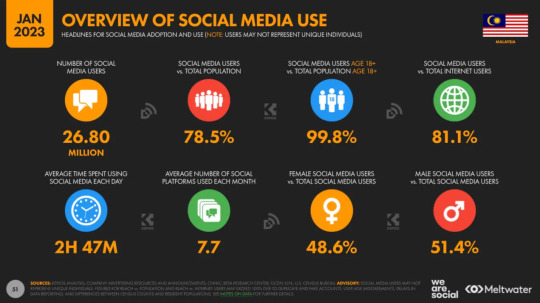
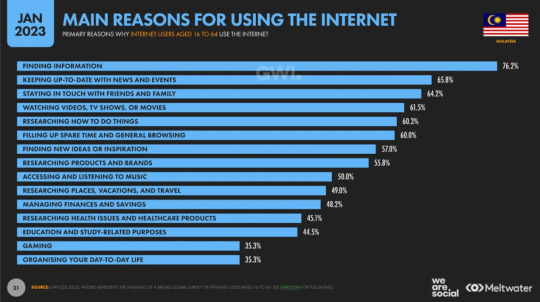
During the early phases of the COVID-19 pandemic, the increased social media activity in Malaysia played a crucial role. Malaysians were well-connected digitally, as they spent an average of 2 hours and 47 minutes daily on social media, surpassing the global average by a significant margin. This participation was primarily motivated by the need to obtain information (76.2%) and keep up with news and events (65.8%). Facebook, Twitter, and WhatsApp were the primary sources for vital updates, news, and recommendations. This ongoing flow of information helps increase the awareness and preparedness of the digital community (Howe, 2023).
2. Real-time Updates
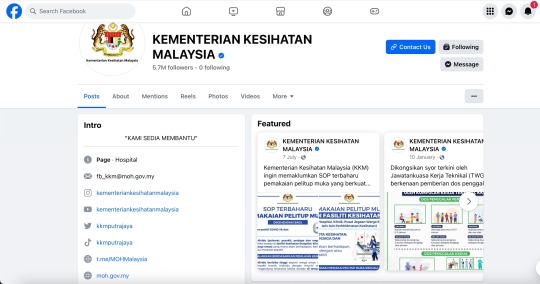

The Malaysian government provided up-to-date COVID-19 information via e-government and social media. They relied on channels such as the Ministry of Health's Official Portal, specialised Facebook pages (such as CRPC and KKM), and the CPRC KKM channel on Telegram. The Director-General of Health's daily press briefings are not only broadcast live on television but also live online via Facebook. In April 2020, they released the MySejahtera mobile app to assist users in monitoring their health and reporting check-in locations, allowing for prompt responses to control the spread of the virus (Dawi et al., 2021).
3. Community Support

During these difficult times, social media has been essential in helping Malaysians feel more connected to one another, with many Facebook groups and online communities offering information and support. For example, neighbours used platforms such as Nextdoor to offer assistance to those in need, and digital communities united in unprecedented ways to share resources and aid one another (FMT Media Sdn Bhd, 2020). Moreover, #benderaputih groups were formed on Facebook to share addresses for assistance and information on local food banks, with Malaysians in need flying white flags outside their residences to indicate distress. The digital community, including neighbours, personalities, and businesses, responded by donating food and other necessities, demonstrating the power of social media to bring communities together in times of crisis (BBC News, 2021).
4. Countering Misinformation
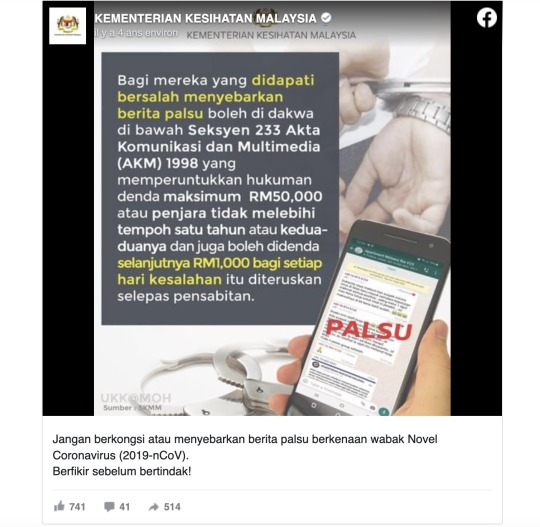
By actively utilizing social media, the Malaysian Ministry of Health (KKM) has taken significant measures to combat COVID-19 misinformation. Through their official social media channels, KKM provides accurate and up-to-date information, dispels misconceptions, and addresses concerns, ensuring that the public receives trustworthy information and is better equipped to make informed decisions during the pandemic. In addition, KKM has released information about the repercussions of disseminating false information. This proactive approach not only helps counter Misinformation but also fosters a sense of trust in official sources, which is crucial during a public health crisis (Euronews, 2020).
The Dark Side of Social Media in COVID-19 Information Spread
1. Misinformation and Rumors

In Malaysia, as in many other countries, social media has served as a breeding ground for Misinformation and rumors about COVID-19. Facebook and WhatsApp have been used to spread false information about the virus's origins, prevention, and treatment options. This has led to public confusion and, in some cases, hazardous behavior, such as disregarding medical advice. False information can undermine the efforts of health authorities and exacerbate the pandemic's effects, causing unnecessary alarm (Balakrishnan et al., 2021).
2. Amplification of Fear

Despite its many advantages, social media can be a double-edged instrument, particularly during a crisis such as the COVID-19 pandemic. One of its negative characteristics is its potential to amplify fear and anxiety. Sensationalized headlines and the dissemination of misleading images can elicit strong emotions, resulting in increased stress and negative effects on mental health. The internet has been rife with misleading information about the virus, including conspiracy theories and misleading statistics. There have been instances where images fraudulently purporting to depict the coronavirus under a microscope have caused panic and confusion. Such false information can be extensively disseminated on social media platforms like Facebook, inciting panic and undermining accurate comprehension (Euronews, 2020).
Conclusion
In conclusion, social media has proven to be a powerful tool in spreading information about COVID-19 in Malaysia. During the pandemic, it rapidly disseminated vital information and connected people, nurturing community and support. The government's use of social media channels contributed to disseminating timely information to the public. However, this has a negative aspect: disseminating false information and terror. Misinformation and sensationalized content have led to public perplexity and hysteria. To maximize the benefits of social media, we must use it responsibly and ensure that accurate information prevails, particularly during the pandemic. Connecting and informing us, social media can be a force for good, but it is up to each of us to ensure that it serves our best interests.
Reference list
Balakrishnan, V., Ng, K. S., & Rahim, H. A. (2021). To share or not to share – The underlying motives of sharing fake news amidst the COVID-19 pandemic in Malaysia. Technology in Society, 66, 101676. https://doi.org/10.1016/j.techsoc.2021.101676
BBC News. (2021). Malaysians in Covid lockdown fly white flags to ask for help. BBC News. https://www.bbc.com/news/world-asia-57717214
Dawi, N. M., Namazi, H., Hwang, H. J., Ismail, S., Marešová, P., & Krejcar, O. (2021). Attitude toward protective behavior engagement during COVID-19 pandemic in Malaysia: the role of e-government and social media. Frontiers in Public Health, 9. https://doi.org/10.3389/fpubh.2021.609716
Euronews. (2020, January 30). Coronavirus: Malaysia arrests five for spreading misinformation online | #TheCube. Euronews. https://www.euronews.com/my-europe/2020/01/29/coronavirus-malaysia-arrests-five-for-spreading-misinformation-online-thecube
FMT Media Sdn Bhd. (2020). Nextdoor: Free network connecting neighbours in quarantine. Freemalaysiatoday. https://www.freemalaysiatoday.com/category/leisure/2020/03/29/nextdoor-free-network-connecting-neighbours-in-quarantine/
Howe, S. (2023). Social Media statistics for Malaysia [Updated 2023]. Meltwater. https://www.meltwater.com/en/blog/social-media-statistics-malaysia
5 notes
·
View notes
Text
Blogging in the era of TikTok and Instagram ///!!
In today's digital environment, it is important to consider if blogging is still relevant in the era of TikToks and Instagram. We may take into account a number of factors, such as communities, socialisation, digital data, and organisations, to investigate this subject.
Communities:
Blogging: Historically, specialised groups and subject matter experts have used blogging as a platform. Bloggers frequently provide material that appeals to specialised interests and subject matter. These groups of people may be incredibly helpful and engaging. TikTok and Instagram: These two platforms also contain communities, although their behaviours are usually rather different. Platforms for sharing short movies and images build communities around popular culture trends, influencers, and aesthetic ideas. Instead of extended conversations, engagement frequently consists of likes, comments, and shares.
Socialisation:
Blogging: Blogging enables in-depth topic investigation and fosters deliberative dialogue through comments. It encourages long-form material that encourages in-depth discussion and analysis. TikTok and Instagram are two sites that emphasise rapid and attractive content more than others. Through likes, emoticons, and brief remarks, they promote social interaction. The exchanges are frequently more informal and centred on visuals.
Digital Data:
Blogging: A considerable volume of text is produced by blogs. This information may be used for SEO (Search Engine Optimisation), making it an important source of organic traffic over the long run. Bloggers may get in-depth information about user behaviour and content performance from analytics tools. TikTok and Instagram are two social media sites that produce a lot of graphic and video content. Although they provide analytics tools, the data may be more difficult to understand and the content's shelf life is frequently shorter owing to the frequent revisions.
Organisations:
Blogging: For content marketing, thought leadership, and SEO, many organisations continue to see value in blogging. A technique to build authority and offer in-depth information is through blogs. Organisations frequently utilise TikTok and Instagram for visual marketing, influencer collaborations, and brand recognition. Short-form material might be useful for swiftly reaching larger audiences.
In conclusion, the objectives and tastes of content producers and users will determine if blogging is still relevant in the TikTok and Instagram era.

7 notes
·
View notes
Text
Did Boris Win Over the Internet?
or "Did Boris Johnson and the Conservatives win the 2019 UK general election using YouTube?"

Setting the Political Stage
Odd title, I agree. But I believe it was the only way to describe what occured in the 2019 UK General election that saw Boris Johnson and his Conservative Party win a landslide victory in the midst of low approval ratings and the hot potato that was Brexit.
To give a brief rundown of what happened, the official Conservative Party YouTube channel posted a series of videos which consisted of election adverts that broke the stereotype of the corporate style often used by politicians. Eight videos were posted in the style of popular internet trends ranging from Q&As, parodies, vlogs, and electronic music, things that would not normally be associated with a ruling party of a major world power.
Boris and the Conservatives, also known the Tories, surpassed everyone's expectations won an outright victory in the polls. His party saw over 48 new seats in parliament and secured the popular vote by over 3 million votes. The Labour Party, the UK's main opposition party, suffered such a major defeat that Labour leader Jeremy Corbyn, stepped down as Labour party leader.
So, how did Boris pull it off? How did one of the most controversial prime ministers in the history of UK politics win a landslide victory? I would like to propose the idea that his bizarre use of YouTube, whether directly or indirectly, helped him secure his mandate.

Understanding Boris
For almost two decades, Johnson has distinguished himself as the "odd man out" in mainstream British media and politics. Purnell (2011) describes Boris' educational background and it is quite remarkable, being an Eton and Oxford graduate, and former president of the prestigious Oxford Union where he initially developed his eccentric persona that we know today.
His early career consisted of being a journalist, being a political correspondent for The Daily Telegraph and later editor of The Spectator. During his time at the Telegraph, he made a film for BBC Newsnight in 1998 about supermarkets while shopping for groceries himself. He was launched into the mainstream when he was elected as Mayor of London in 2008. And during the administration of Prime Minister Theresa May between 2016 and 2019, Boris served as Foreign Secretary, adding another rung to his ladder to the top.
And in July 2019, Boris reached the zenith of any British politician and became prime minister. He inherited a hung parliament, meaning his party lacked a majority in the House of Commons. This made it difficult for him to pass any legislation, let alone the necessary legislation to secure Brexit. Therefore he took a gamble and called for a general election to be held in December. The situation did not seem to favour the Tories in the slightest and most expected them to be voted out of government as long as Boris was the face of the Conservatives. Now we reach the meat of the matter, the YouTube videos.

The YouTube Campaign
Beginning from 13 November, the Tory Party YouTube channel started posting election adverts that were styled more akin to popular entertainment oriented videos usually seen from WIRED. The first video of this style posted on 13 November was titled "12 Questions to Boris Johnson" and was structured like an impromptu and informal Q&A with Boris during his tea break at the Conservative Party office. He portrays himself as a just another normal person at the office as he asnwers questions about Brexit and other pressing election matters.
The second video, uploaded on 26 November, was not like any other as it was a music video. Titled "lofi boriswave beats to relax/get brexit done to", the video is more than an hour long and just consists of a picture of Boris on a train and a music track of lofi beats with excerpts from Boris' speeches. The speeches cover topics that range from getting Brexit done, increase funding for health services, and increased police funding.
The subsequent videos include Boris' honest opinions where he vlogs himself answering questions about government policies, a Love Actually parody in which he recreates a scene from that film but inserts his campaign promises into the scene, and finally there is Gridlock Vs Tractor where Boris drives a tractor and crashes through a wall to symbolise the breakthrough in Brexit negotiations.

Hits to Votes?
Did Boris' gamble with the YouTube adverts lead to him earning the mandate and winning a landslide? It is indeed the hot question on everyone's mind who reads this. Looking at the numbers, we can see that cumulative views of all five videos add up to the over 3.2 million views, with the Boriswave video making up the bulk of the views at 42.4%. According to the BBC (2019), the Tories won the popular vote overall with 13.9 million votes while Labour got 10.2 million, with a difference of 3.6 million votes. Though those numbers might be comparable, taking into account that someone watching the video could have shared his or her screen with a friend or two, thus influence their voting preference.
The YouTube adverts were certainly eye catchers during the election campaign and did make headlines, giving Boris more screentime and getting more people to talk abut him. The thing about the videos is that they are exactly something that Boris would definitely agree to be involved in its making as it aligns with his eccentric and unorthodox methods of gaining publicity. Now I have to be frank when I say on a more serious note that it is very unlikely that the YouTube videos alone helped with the electoral success of the Conservatives. The 2019 general election centred on complex socio-political issue that plagued UK politics at the time which included the UK's referendum to leave the European Union known as Brexit, funding of the National Health Service and health workers' salaries, and overall confidence voters have in the government. People were generally more concerned with how the aforementioned the issues would be addressed by Boris' administration rather than his social media gimmicks.
Therefore, the answer to the question whether or not Boris successfully courted his internet audience is unlikely. Even if he gained new supporters through his YouTube videos, his most recent scandals and controversies would have put people off being potential Conservative voters. And even if the answer is no, it has been an enlightening discussion on how Boris sealed his persona online as the "odd man out" in British politics. This might be a disappointing conclusion to our discussion, but it is incredibly fascinating topic to delve into and ask these questions on how politics and internet culture converge.

References
Purnell, S 2011, Just Boris: The Irresistible Rise of a Political Celebrity, Aurum Press, London
Gimson, A 2012, Boris: The Rise of Boris Johnson, Simon & Schuster, New York
youtube
4 notes
·
View notes
Text
‘Do memes provide a useful way of understanding politics?’
Before we get into our topic, what exactly is a memes? These days, memes have grown in popularity. A meme, in my opinion, is a piece of information that is hilarious, goes viral on the internet, and may be remixed and changed over time. These are also the main elements that define a meme. As to Pettis's (2018) study, Richard Dawkins provided the initial definition of the term "meme" in his book ‘The Selfish Gene’. The term "memes" was first used by Dawkins (1976) to describe the transmission of ideas virally. Memes are similar to biological "genes" in that they are self-replicating and convey information, opinions, perceptions, and beliefs that are shared across individuals (Kasirye 2019). Dawkins defined a meme as any unit of culture that might be copied and transmitted among humans; examples of such units of culture include popular songs, fashion trends, or religious traditions (Pettis 2018). Dawkins did not define memes only as pictures and videos.

Do memes provide a useful way of understanding politics?
Even though memes might be a fun method to share knowledge, they are not a reliable tool for understanding political topics in their entirety. For what reason? Memes frequently employ humour, satire, or exaggeration to express a point; it is impossible to determine if the content is real or fabricated. It could also include bias from the author. For instance, if I dislike a politician, my memes will highlight all of their flaws, even if they are good politicians overall. However, it also offers a useful way of knowing politics, as shown in the memes below. Through this meme, teens will know that who is our Prime Minister and what happen between them.

Memes provide a useful way of understanding politics because of the funny point, it can attract teenagers easily, compared to news. It can serve as a gateway for young people to become more politically aware and involved.
Simplified Political Messaging
Besides, the complexity of political messages is another reason why the majority of people in today's society don't fully understand politics. Political information is more widely available to the general public because to memes, which frequently create complicated political messaging into formats that are easy to understand. For instance, the government usually makes announcements through news or videos during the MCO time. Personally, I am lazy to bother watching these announcements, especially because the most of them are in Bahasa Melayu. Because of memes, they made the announcement in this instance easier for me to understand. Memes need to be humorous and relatable, like I already stated. On these two main components, they simplified political message, people began to share with their friends, and the general public began to understand politics. However, this can also lead to the dissemination of false information or misinformation due to the bias of the authors.

Impact of Politics Memes
In 2019, the government officially announced that the voting age would be lowered from 21 to 18 years old. But when it comes to voting, memes could have an impact. Since those teens have minimal political knowledge, they will select politicians who frequently appear in memes. Participants may also use an anonymous account to publish their own memes in order to market themselves and make teens remember them. In the book "Memes in Digital Culture," Shifman explains how memes were effectively used in the US election of 2008. Because to memes, Obama received around 70% of the vote among Americans under 25 in the 2008 US presidential election (Oakes 2020). Politicians may create humorous content and advertise a nice, friendly image to the public by using memes. They will be able attract more teenagers to vote for them if they use this strategy.

Conclusion
Memes, in my opinion, can help us understand politics, but only if we are able to identify the difference between information that is true and that is fake. Political memes may make politics easier for pupils to recognise and comprehend than heavy textbooks, especially for those taking history exams. Additionally, because of its hilarious element, which makes politics less boring, and since it is simple to attract people in, it is also a helpful approach to learn about politics.

References
Dawkins, R 1976, The Selfish Gene , download.booklibrary.website, viewed 19 October 2023, < https://download.booklibrary.website/the-selfish-gene-richard-dawkins.pdf>.
Kasirye, F 2019, ‘THE EFFECTIVENESS OF POLITICAL MEMES AS A FORM OF POLITICAL PARTICIPATION AMONGST MILLENNIALS IN UGANDA’, Journal of Education and Social Sciences, vol. 13, no. 1, viewed 20 October 2023, <https://www.jesoc.com/wp-content/uploads/2019/08/KC13_032.pdf >.
Limor Shifman 2014, Memes in Digital Culture, The MIT Press, Cambridge, Massachusetts, viewed 20 October 2023, <https://research.ebsco.com/linkprocessor/plink?id=348695e0-233d-3fc5-9070-95351505ffab>.
Oakes, A 2020, How has social media changed the US presidential election?, New Digital Age, viewed 21 October 2023, <https://newdigitalage.co/social-media/how-has-social-media-changed-the-us-presidential-election/>.
Pettis, B 2018, ‘Pepe the Frog: A Case Study of the Internet Meme and its Potential Subversive Power to Challenge Cultural Hegemonies’, Scholars’ Bank (University of Oregon), University of Oregon, viewed 17 October 2023, <https://scholarsbank.uoregon.edu/xmlui/bitstream/handle/1794/24067/Final%20Thesis-Pettis.pdf?sequence=1&isAllowed=y>.
Shifman, L 2013, ‘Memes in a Digital World: Reconciling with a Conceptual Troublemaker’, Journal of Computer-Mediated Communication, vol. 18, no. 3, pp. 362–377, viewed 20 October 2023, < https://academic.oup.com/jcmc/article/18/3/362/4067545>.
9 notes
·
View notes
Text
Do Memes Provide a Useful Way of Understanding Politics?
In the age of social media, the political landscape has undergone a significant transformation. Politicians no longer depend on traditional campaign strategies to connect with the masses. Today, memes have become a powerful tool in the realm of politics. But do these humorous, often irreverent images and videos provide a useful way of understanding politics? In this blog post, I'll delve into the world of political memes in Malaysia and explore their role in shaping digital communities and sociality.
The Rise of Memes in Malaysian Politics
Malaysian politics has witnessed a remarkable evolution in recent years, with the Internet and social media playing a pivotal role in shaping political discourse. Memes, as a form of user-generated content, have become an integral part of this digital landscape. They are short, catchy, and easily shareable, making them a perfect medium for engaging and mobilizing the electorate (Shifman 2013). To illustrate, in the preceding 2023 Malaysian general election, political parties and candidates effectively harnessed memes on platforms such as Facebook, Instagram, and Twitter to connect with the younger, tech-savvy demographic.

Meme Culture and Sociality
The unique culture surrounding political memes in Malaysia can be exemplified by the phenomenon of "political meme pages" on social media platforms. Numerous pages and groups are dedicated to creating and sharing political memes, where users participate in discussions, debates, and humour-filled exchanges. As an example, the "Zunar Cartoonist Fan Club" Facebook page has garnered substantial acclaim for its witty interpretations of Malaysian politics, fostering a strong sense of community among its dedicated followers. This demonstrates how meme culture has not only become a form of commentary but also a means of building a shared digital identity.

Understanding Complex Issues through Memes
One of the intriguing aspects of political memes is their ability to simplify complex issues (De Leon & Ballesteros-Lintao 2021, p.6). Malaysian politics is no stranger to intricate policies and controversies, but memes have a knack for breaking down these topics into digestible, often exaggerated, forms. This not only helps in spreading awareness but also encourages discussions among citizens who might have otherwise felt overwhelmed by the intricacies of politics.

Digital Activism and Social Change
Memes are more than just a source of passive entertainment; they can serve as a catalyst for social and political transformation. As an example, during the Sheraton Move in 2020, Malaysian netizens created and circulated memes that critiqued the government's alleged actions. These memes played a pivotal role in increasing awareness of the issue and galvanizing public sentiment against the perceived misconduct (Leiser 2022, p. 245). The use of memes as a form of digital protest and social commentary showcases their potential to hold politicians accountable and drive change.

The Dark Side of Memes in Politics
While memes can be a force for good in Malaysian politics, they also have a dark side. Misinformation, fake news, and character assassination are common pitfalls (Salam 2018). For instance, consider the case of Ikmal Hisham, a politician affiliated with Perikatan Nasional (PN), who found himself unjustly accused of vaping when a meme featuring him merely holding a cylindrical pen went viral across a multitude of social media platforms (Malaysiakini 2023). Therefore, it's essential to strike a balance between humour and responsibility, ensuring that memes do not undermine the integrity of political discourse.

Conclusion
In the world of Malaysian politics, memes have emerged as a powerful tool for understanding and engaging with the political landscape. They bridge the gap between the complexities of governance and the everyday experiences of citizens. Through humour and satire, they foster a sense of community and activism within the digital sphere.
However, it's crucial to approach political memes with a critical eye. They should not replace traditional news sources but complement them. The responsibility of fact-checking and ensuring the accuracy of information falls on both creators and consumers of memes.
In the end, memes provide a unique lens through which we can view and understand politics in Malaysia. They offer a glimpse into the collective consciousness of the digital community and serve as a reminder that in this interconnected age, politics is no longer confined to traditional boundaries—it thrives in the virtual world, where ideas and opinions are shared one meme at a time.
Reference List
De Leon, FMG & Ballesteros-Lintao, R 2021, 'The rise of meme culture: Internet political memes as tools for analysing Philippine propaganda', Journal of Critical Studies in Language and Literature, vol. 2, no. 4, pp. 1-13, viewed 10 October 2023, < https://jcsll.gta.org.uk/index.php/home/article/view/70/143>.
Leiser, A 2022, 'Psychological Perspectives on Participatory Culture: Core Motives for the Use of Political Internet Memes', Journal of Social and Political Psychology, vol. 10, no. 1, pp. 236-252, viewed 10 October 2023, <https://jspp.psychopen.eu/index.php/jspp/article/view/6377/6377.pdf>.
Malaysiakini 2023, 'Saya pegang pen, bukan hisap vape', 21 September, Malaysiakini, viewed 12 October 2023, <https://www.malaysiakini.com/news/679974>.
Salam, A 2018, 'The Hoax Phenomenon in Indonesian Society: Observing Anti-Diversity Memes since 2014', Gadjah Mada University, vol. 30, no. 3, pp. 314-324, viewed 10 October 2023, < https://d1wqtxts1xzle7.cloudfront.net/63926674/0938891-103625-1-PB20200715-14109-1jsdsaq-libre.pdf?1594816369=&response-content-disposition=inline%3B+filename%3DThe_Hoax_Phenomenon_in_Indonesian_Societ.pdf&Expires=1697549211&Signature=bJ9~skzTYbD23PIgStMSf10Uju6bFq7B-3fPjNbG-0x9wEyztGkLEZJ0xv6cWqRZMzVUbTLKAMe-L4nIrQ4~27bGWDmoBcyRLnB130dDf1oDM0nhyptfWSbMuobR1lVzfUI1A1Lcx0kNcoKU677DKkedeOXlBd35F-gp-Jbq2Qx4~On-Mj8jNL4sEYIcvXDgPvQWoNV5DysJtyoWV2vxquqyrtdPtpQOSNoDJiZ0MPyguyxXcMIGJJgEm3tguVew6Y0BODRRLwmkX1RQmZYXATpW2Kj85tt6QObOfJYilxKjIDTSBBMRRq7U8YZ5ORWs1xiSV8s1s3a~OVN0fCykyQ__&Key-Pair-Id=APKAJLOHF5GGSLRBV4ZA>.
Shifman, L 2013, 'Memes in a digital world: Reconciling with a conceptual troublemaker', Journal of Computer-Mediated Communication, vol. 18, no. 3, pp. 362–377, viewed 9 October 2023< https://watermark.silverchair.com/jjcmcom0362.pdf?token=AQECAHi208BE49Ooan9kkhW_Ercy7Dm3ZL_9Cf3qfKAc485ysgAAA1EwggNNBgkqhkiG9w0BBwagggM-MIIDOgIBADCCAzMGCSqGSIb3DQEHATAeBglghkgBZQMEAS4wEQQMsx2iZgcDFb_thnGZAgEQgIIDBD0_Q7fNS3prEYCwj0DfqtSmrZ0j3P4UvPrtkN9aSzsQZPavYTwGd5WN0knOPOSQrilBrYHiVKqjGxB8Qccn2-BXh8p6cwri9_Tr0sFxfBVfstZEiWBIlRwsXoIqKUENymdD_slY9FTV0RFI7b1BqmzqC3a2-J994gRw-IvAmWxpc8ULscC--ZAAYN0egn5DX3gzHKKnG2REMVYKCeTGX_R7wFP1sNPcpm9lByHSBjhucf3bp7fHN1d6ER267gugrYnHqpUD5n7qCLpYqUBxwYG2JM4UDoKHekbyHj5gWfXnRvP6zYDDryQ6BVx2WTx5j4VgHHxfaQNwLtJxQjInmmLpAFXgCOaTmCVM5UezGQ8B5sBTKCwIiRVQJLiexMwm3QxBQEW7xQp_OHdGBraaMuTa-gjTDTHTzSFncPl8lKZ1XINQklrEylrpP9v6fGUVIQb2YS8VOqhAfHLgyAGMVf0in-i_0T8t2DiI9mXRf0K4J98FolVs130d33WeNHsrhgowI9bhalU5fwYQJH5qRhW39SgwyGUu6et4lyaL7nLlmt2Hn_wM728CCaEQJEe0hCXNGoAQu5ckdSF_JabbRMK5aDSdHXle5MXC0PVUAjh117aYGtBRkw5_ps3SbP6IKuR5BANg8JIjWCUrzkfc9OCP990fh1FMRREkgD4VWSeWiJxyGeVgstubOzKSrlUyfJ-YuzMqYgyvgx0p_hsULC8x8IlNEUVWRpVKLj8iqu5dTu1CW7MzORujXD_lSx2npZYpbpsT1p9S5GrMZaplIL0gP4w2greyRLp5OE3kz3TP_80G_HAMooX0j_5-sXf7QKs1ekAwA9G-Ci2mA_20VLxwxXwhKrf54fPtZENzQ3Z_RYIhXpirYqwRGndbYWoYqfiRzAdG3xX0BGndRXKBIHjdsXFHLofaZWyUU3ayLd9rLK02MupPZlAElyFGEokcxSG7if6bSFMIYuJe4YUAoT6ZALrAB7MUgsP84AoSwxfFFQSyL1gHKDCiLveeCDn4LfKNigA>.
3 notes
·
View notes
Text
Is blogging still relevant in the age of TikToks and Instagram?
Hi, it’s blondietalks here! On this week of my Digital Communities thread, I will be exploring the topic of blogging and its relevance in the current Internet atmosphere.
In my opinion, blogging is still relevant in some ways. However, it is incomparable to the relevance of TikTok and Instagram as the public spheres on these platforms are getting more engagement by the day.
The Pilot episode of the Internet: Blogging
Blogging was the foundation of the rise of the Internet. Blog websites – formerly known as weblogs, created the first public sphere for people all over the world to come together online. Before blogging, traditional websites that were set up by big companies did not allow a two-way communication system for the readers to interact with (Duermyer 2022). Blogs have become a public sphere by allowing equal participation for the users and the sharing of public opinion.
Knowing this it is no surprise that a large chunk of users still use the Internet to blog as their way to embody their online presence. Being a part of the blogging community – for example, being a member of a subgroup on Reddit – gives people a sense of community and support from the peers whom they interact with. In all its glory, people still blog because there are others who still demand for it and engage with it, in turn making it somewhat relevant.
The Relevance of Blogging
When people search on Google “why does my Epson printer won’t go online”, they most likely wouldn’t want to watch a whole video explaining why. This is where blog posts come in handy when people are searching for content that they can glance through quickly. Blog posts are still mainly the first result that appears when you search for a topic on Google. The Google algorithm that prevails blog websites on their platform is what keeps these blogs around.
Some people turn to blogging because it gives them a sense of anonymity. For people outside of my circle, you wouldn’t know who I am writing this blog post on Tumblr. People feel more comfortable writing their thoughts online instead of recording a video of themselves talking on media-based platforms. Based on an article on BBC (2021), online anonymity helps people to openly speak up about their concerns while protecting their privacy. Using platforms that focus on pieces of writing instead of media that might expose their identity allows the participation of anonymous users.
Blogging vs. TikTok and Instagram
So how does blogging fit in the current rise of TikTok and Instagram?
Blogs are getting less engagement these days because people are more attracted to fast-paced content. As the attention span of social media users get shorter and shorter, content that are digestible and easy to follow will get the engagement that they strive for.
An example of how Instagram can be used to capture the attention of social media users is the phenomenon of spreading political and environmental education with the use of infographics. Instead of reading through lengthy blogs about a chosen topic, resourceful accounts such as the Instagram account below make information more digestible and attainable for people.

@/impact on Instagram posting an infographic about the history of slavery. Link: https://www.instagram.com/p/CwS5HGGu1wH/?hl=en&img_index=1
People also prefer TikTok and Instagram over blog websites because of the intelligent algorithms that these applications offer. These platforms can learn a user’s interest just by their engagement and activity on the application. According to Huang (2022), generation Z are using TikTok as their search engine because of its powerful algorithm that makes searching for information more convenient. TikTok is constantly learning the user’s behaviour and presenting them with content that is in their favour.
Video-based platforms give people an enriched experience with visual stimulation compared to blog websites. Based on Huang (2022), a TikTok user stated that a restaurant review on the application feels more genuine based on watching the reviewer’s facial expressions. People use TikTok to obtain product and establishment reviews because they can observe it first-hand through video recording.
The conclusion
So, in conclusion, just because blogging is not trending through the charts anymore, that doesn't mean that it’s completely irrelevant. I believe that blogging is still relevant as ever because people will go back and forth between platforms and in ways of expressing themselves on the Internet. Some days they feel like hopping onto TikTok trends – and another day they might write up their opinion on Tumblr under a hashtag that no one else is reading through.
That's all for this week, catch up with you guys soon :)
List of references Duermyer, R 2022, ‘What is blogging?’, The Balance, 29 November, viewed 1 October 2023, <https://www.thebalancemoney.com/blogging-what-is-it-1794405>. Huang, K 2022, ‘For Gen Z, TikTok is the new search engine’, The New York Times, 16 September, viewed 1 October 2023, <https://www.nytimes.com/2022/09/16/technology/gen-z-tiktok-search-engine.html>. BBC 2021, ‘Social media: should people be allowed to be anonymous online?’, BBC, 26 February, viewed 1 October 2023, <https://www.bbc.co.uk/newsround/56114122 >.
22 notes
·
View notes
Text
Is Blogging Still Relevant in the Age of TikToks and Instagram?

In the ever-evolving landscape of digital media and communication, the question of blogging’s relevance looms prominently.
Living in today’s era where our media consumption habits are dominated by the instant gratification of TikToks and the visual allure of Instagram, blogging, which once reigned supreme as the platform for personal expression and information sharing, appears to have lost some of its ✨sheen✨.

But before we get ahead of ourselves, let’s dive deeper into these three platforms and explore their developments and growths, and where they stand in the invisible ranks of the Internet today.
Let’s turn back the time and celebrate the births of blogging, Instagram and Tiktok!

Every day, I wake up and reach for my phone almost immediately. While scrolling through the Instagram reels and TikToks sent to me by the people I know, I sometimes pause and just wonder aloud, ‘How did these apps even come about?’.
Well, silly questions like this never bothered me before – everyone’s had their existential crises. But the lingering question of ‘How did the apps that we use today come into existence?’ kept me up some nights, so I knew I had to get to the bottom of this.
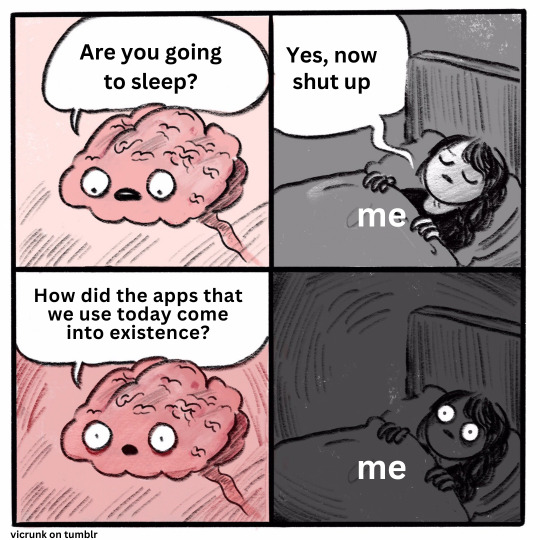
As we all know, blogs are the oldest of the three. Justin Hall is the founder of the first blog called ‘Links.net’ all the way back in 1994, though he referred to it as a “personal homepage” instead (Rioja 2020).
The term ‘weblog’ was later introduced in 1997, followed by the shortened version – ‘blog’ – in 1999, the term we are more familiar with today (Rioja 2020). In the early 2000s, blogging became a famous online activity as more blogging platforms and websites came to life, increasing Internet surfers’ accessibility to the blogging industry (Rioja 2020). By 2010, blogging had permeated the general public and became mainstream (Rioja 2020).
As the years pass and technology advances, the blogging experience we know of today was conceived.

Instagram – the ‘middle child’ of the three – was conceived in 2010.
However, did you know that Instagram’s first life began way before then, and was originally called ‘Burbn’ instead as a nod to the founder’s love for bourbons (Langrio-Chafkin 2012)?
Long story short, just like Instagram today, Burbn was also a photo-sharing app that allowed users to share locations (Garber 2014).
However, it was found that most of Burbn’s users left the location check-in feature untouched but went wild with sharing and posting pictures (Garber 2014). This led the founders to shift their focus on Burbn’s photo-sharing abilities and scrapped almost everything else. After months of research and experimentation, Burbn was reborn as Instagram in 2010 (Garber 2014).
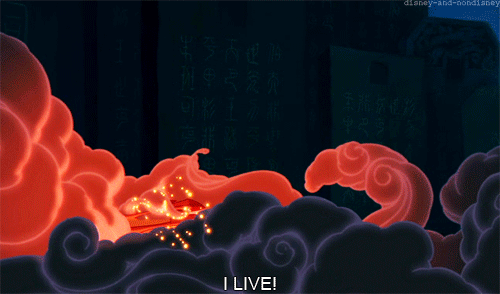
Lastly, introducing TikTok, the youngest of these three platforms. Despite its greeness, TikTok has arguably one of our generation’s largest and most active user bases.
In 2016, Chinese company ByteDance introduced a Chinese app called Douyin and its counterpart app called TikTok, which was launched internationally (Anderson 2020). When ByteDance merged Musical.ly (a lip-synching video-creation app) with TikTok in 2018, many more people downloaded TikTok, and the numbers only increased after Vine was shut down (Anderson 2020).

Today, TikTok is viewed more as a creative platform than a conventional social media platform, where users can break away from traditional visual styles, narratives, and online customs of the past to create and share short-form videos as they desire.
The rise of Instagram and TikTok over the recent years has introduced new forms of content consumption and creation that shifted the digital landscape.
Understandably, most Internet users nowadays prefer the two apps over blogging for several reasons, such as the ability to share visual and short-form content, a more mobile-friendly experience, and algorithm-driven feeds which curate the posts and videos according to the user’s preferences.
So… Does this mean that blogging is dead?
Simply put, no.

While it may seem like TikTok and Instagram are dominating the media world nowadays, each platform, in fact, still has its own user base due to its distinct features. Although blogging may not seem as prevalent as it used to be, people still enjoy consuming and creating blogs, especially if they prefer reading longer and more informational written posts.
Safe to say, blogging is definitely still relevant in today’s age of TikToks and Instagram. As long as the passion for reading and writing persists, blogging may never see the face of extinction 💪
---
References
Anderson, KE 2020, ‘Getting acquainted with social networks and apps: it is time to talk about TikTok’, Library Hi Tech News, vol. 37, no. 4, pp.7-12, <https://doi.org/10.1108/LHTN-01-2020-0001>.
Garber, M 2014, Instagram was first called 'Burbn', The Atlantic, viewed 2 October 2023, <https://www.theatlantic.com/technology/archive/2014/07/instagram-used-to-be-called-brbn/373815/>.
Langrio-Chafkin, C 2012, Kevin Systrom and Mike Krieger, founders of Instagram, Inc., viewed 2 October 2023, <https://www.inc.com/30under30/2011/profile-kevin-systrom-mike-krieger-founders-instagram.html>.
Rioja, A 2020, The evolution and history of blogging: where it began and where is it now, Alejandro Rioja: SEO, Online Marketing and Ecommerce, viewed 2 October 2023, <https://alejandrorioja.com/history-of-blogging/>.
3 notes
·
View notes
Text

With the rise of Instagram Reels and TikTok videos, it seems as though blogging has become a thing of the past... or has it? Let's see if blogging is still relevant in the age of Instagram and Tiktok.
The Early Days:
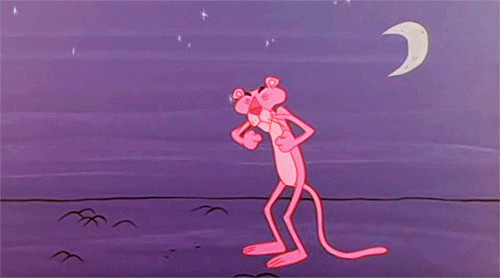
Blogging first became a thing when Justin Hall created what he called his "personal homepage" on Links.net, where he reviewed HTML examples from other online links (Zantal-Wiener 2020). 3 years later, Jon Barger, a fellow blogger, coins the term "weblog", reflecting the process of logging the web. Another 2 years later, Peter Merholz, a programmer, shortens the term "weblog" into "blog", to which Merriam-Webster would declare as the word of the year in 2004 (NDMU 2018).
~ TLDR ~
1994 - Justin Hall's "personal homepage" on Links.net
1997 - Jon Barger coins the term weblog
1999 - Peter Merholz shortens "weblog" -> "blog"
2004 - Merriam-Webster declares "blog" as their word of the year
The prime time of internet exploration (for the masses) between the late-90s and early-00s are also home to the births of iconic blogging platforms such as Blogger and WordPress (NDMU 2018).
These early days were the chance for the readers and writers of the world to digitalise their bibliophilic habits as they ventured new ways to connect with bookworms across the globe.
The Evolution:

Right in the midst of blogging's mainstreaming years, the public launching of YouTube in 2005 sparked the evolution of blogging. With that, the wonders of blogging were no longer confined to the wordsmiths of the world.
YouTube's culture of video blogging, or vlogging, appealed to those who preferred audio and visual stimulation, thus continuing the reach of blogging as a whole (Maslanka 2017). This video blogging culture brought forth most of the blogging cultures still in tact today, such as the aforementioned Instagram Reels and TikTok videos, which are forms of blogging that invoke creativity in a different medium than what blogging first started as.
The Question:
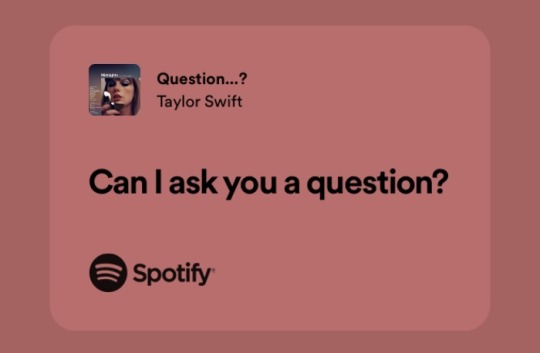
lyrics captured from Spotify
So blogging evolved from choosing the right writing style to choosing the right background music, but what does that mean? Does no one do the former anymore? Is everyone just trying to accomplish the latter?
Take, for instance, you feel like cooking something new. Some people would turn to a cooking channel on YouTube, while some prefer clicking on the recipe blogs that their search engine compiles for them. My friend would rather watch a video about the newest technology, whereas I would like to read about it in a blog post instead.
It all comes down to personal preference.
Numerous blog platforms are still around and are home to a growing number of blog accounts that cater to different genres of digital communities; because just as many people there are on this planet, exists a vast range of interests, preferences, and personalities. These aspects result in the creation of digital communities that almost anyone can find a seat in. These different groups then evolve within themselves to create their own set of cultures, norms, as well as trends.
So perhaps someone who spends their days watching Instagram Stories and TikTok Lives may seem to think that blogging is a dying flame, but to someone who replies to tweets and writes fantasy fiction on Tumblr, would disagree. In fact, posting short snippets of your day or sharing your thoughts in a tweet is a form of blogging in itself, specifically known as microblogging. Microblogging is an example of blogging cultures trickling down to make room for the readers and writers of the world who enjoy doing so, but in a more casual setting.
It is also important to note that personalities are not a black and white thing. Preferences are not an either or situation. There are many people who enjoy both reading blogs and watching videos.
・・・・・・
Besides leisure pursuits, blog accounts can also be used professionally. Setting up a portfolio blog could serve as a digital gallery of one's work (ThemesKingdom 2019). For example, a programmer's portfolio blog could include the programs they have coded or their experiences with different programming languages. The inclusion of a portfolio blog to a resume helps future employers grasp the personalities, morals, and ethics of the potential employee.
And along the lines of career-oriented blogs are money-making blogs; a solid option for the adventurers who seek a non-conventional career path. These type of blogs often rake in revenue through brand partnerships, affiliate links, premium content or private consultations (Polner & Bottorff 2023).
The Answer:
Definitely! I would confidently say that blogging is still relevant in the midst of Instagram and TikTok's uprising.
While there is no denying that Instagram and TikTok may be more popular amongst certain demographics, the future of blogging continues to march on, because as long as there are bookworms around, blogging will remain relevant ⋆。⋆☂˚。⋆。˚☽˚。⋆
︵‿︵‿ References ‿︵‿︵
Maslanka, M 2017, The Vlog Blog: History of Vlogging, MotionSource, 28 July, viewed 27 September 2023, <https://blog.hubspot.com/marketing/history-of-blogging>.
NDMU 2018, History of Blogging, Notre Dame of Maryland University, 22 March, viewed 27 September 2023, <https://online.ndm.edu/news/communication/history-of-blogging/>.
Polner, M & Bottorff, C 2023, How To Start A Blog And Make Money In 2023, Forbes, 31 July, viewed 29 September 2023, <https://www.forbes.com/advisor/business/start-a-blog/#:~:text=Blogging%20Is%20a%20Fast%20Way,can%20start%20earning%20any%20money.>.
ThemesKingdom 2019, 5 reasons why you should include a blog in your online portfolio, ThemesKingdom, 29 May, viewed 29 September 2023, <https://themeskingdom.com/blog/reasons-to-include-a-blog-in-online-portfolio/>.
Zantal-Wiener, A 2020, A Brief Timeline of the History of Blogging, HubSpot, 19 October, viewed 29 September 2023, <https://blog.hubspot.com/marketing/history-of-blogging>.
21 notes
·
View notes